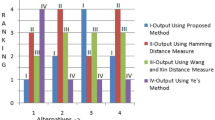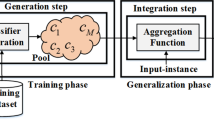Abstract
In this paper, we suggest a new classifier using a multiple-attribute decision-making (MADM) model for fuzzy classification. First, we form a decision-making matrix. Its elements are membership functions of a fuzzy set constructed by training datasets. Then, for any test data, we form an MADM problem, and by solving this problem with a method from the MADM techniques, we obtain a fuzzy classification. For this purpose, we utilize the technique for order of preference by similarity to ideal solution (TOPSIS) method as a well-known method in the MADM techniques. Additionally, we use a new criterion for determining a weight vector for features in this approach. We evaluate the obtained results of the new approach with five well-known algorithms on ten datasets. Also, we compare our new approach with the weightless algorithm and weighed algorithm by the generalized Fisher score in feature selection methods. Finally, to show the superiority of the new approach, we use a statistical comparison with other methods.



Similar content being viewed by others
Explore related subjects
Discover the latest articles, news and stories from top researchers in related subjects.Data Availability
Enquiries about data availability should be directed to the authors.
References
Abaszade M, Effati S (2019) A new method for classifying random variables based on support vector machine. J Classification 36:152–174
Ali R, Lee S, Chung TC (2017) Accurate multi-criteria decision making methodology for recommending machine learning algorithm. Exp Syst Appl 71:257–278
Angelov P, Zhou X (2008) Evolving fuzzy-rule-based classifiers from data streams. IEEE Transactions on Fuzzy Systems, ISSN 1063-6706, special issue on Evolving Fuzzy Systems, 16 , pp. 1462–1475
Bache K, Lichman M, UCI Mach Learn Rep, 2013
Baik S, Bala J (2004) A decision tree algorithm for distributed data mining towards network intrusion detection. lecture notes in computer science, 3046: 206–212
Baloochian H, Ghaffary HR (2019) Multiclass Cclassification based on multi-criteria decision-making. J Classification 36:140–151
Bezdek JC (1981) Pattern recognition with fuzzy objective function algorithms. Plenum, New York
Bezdek JC, Ehrlich R, Full W (1984) Fcm: The fuzzy cmean clustering algorithm. Comput Geosci, (1984), pp. 191–203
Breiman L, Friedman J, Olshen R, Stone C (1984) Classification and regression trees, Wadsworth Int. Group
Brownlee J (2018) Statistical methods for machine learning, Mach Learn Mastery, 2018
Cambria E (2016) Affective computing and sentiment analysis. IEEE Intell Syst 31(2):102–107
Cambria E, White B (2014) Jumping NLP curves: a review of natural language processing research. IEEE Comput Intel Magazine 9(2):48–57
Chaturvedi I, Ong YS, Arumugam RV (2015) Deep transfer learning for classification of time-delayed Gaussian networks. Sig Process 110:250–262
Chaturvedi I, Ong YS, Tsang IW, Welsch RE, Cambria E (2016) Learning word dependencies in text by means of a deep recurrent belief network. Knowl-Based Syst 108:144–154
Chaturvedi I, Satapathy R, Cavallari S, Cambria E (2019) Fuzzy commonsense reasoning for multimodal sentiment analysis. Pattern Recog Lett 125:264–270
Chen G, Ye D, Xing Z, Chen J, Cambria E, (2017) Ensemble application of convolutional and recurrent neural networks for multi-label text categorization. Int Joint Conf Neural Netw, pp. 2377–2383
Cheng J, Greiner R, Kelly J, Bell D, Liu W (2002) Learning Bayesian networks from data: an information-theory based approach. Artificial Intell 137:43–90
Cordon O, Jesus MJ, Herrera F (1999) A proposal on reasoning methods in fuzzy rule-based classification systems. Int J Approximate Reason 20:22–45
Cortes C, Vapnik V (1995) Support vector networks. Mach Learn 20:273–297
Cover T, Hart P (1967) Nearest neighbor pattern classification. IEEE Trans Inform Theory 13:21–27
Dietterich TG (1997) Machine learning: four current directions. AI Mag 18(4):97–136
Duda RO, Hart PE (1973) Pattern Classification and Scene Analysis. John Wiley and Sons, NewYork
Duda RO, Hart PE, Stork DG (2012) Pattern classification, Wiley-interscience
Freund Y, Schapire RE (1997) A decision-theoretic generalization of on-line learning and an application to boosting. J Comput Syst Sci 55(1):119–139
Friedman N, Geiger D, Goldszmidt M (1997) Bayesian network classifier. Mach Learn 29:131–163
Fuentes-García R, Walker SG (2010) A new approach to classification. J Appl Statistics 37:137–146
Fujiyoshi H, Hirakawa T, Yamashita T (2019) Deep learning-based image recognition for autonomous driving. IATSS Res 43(4):244–52
Grillenzoni C (2016) Design of blurring mean-shift algorithms for data classification. J Classification 33(2):262–281
Gu Q, Li Z, Han J (2011) Generalized fisher score for feature selection, UAI, 2011
Guerrero-Ibanez J, Zeadally S, Contreras-Castillo J (2018) Sensor technologies for intelligent transportation systems. Sensors 18(4):1212
Hariri W, Narin A (2021) Deep neural networks for COVID-19 detection and diagnosis using images and acoustic-based techniques: a recent review. Soft Comput 25:15345–15362
He X, Cai D, Niyogi P (2005) Laplacian score for feature selection, In. NIPS
Hung W, Chang Y, Chuang S (2008) Fuzzy classification maximum likelihood algorithms for mixed-Weibull distributions. Soft Comput 12:1013–1018
Hwang CL, Yoon K (1981) Multiple attribute decision making: methods and applications. Springer-Verlag, New York
Iman RL, Davenport JM (1980) Approximations of the critical region of the friedman statistic. Commun Statistics 9:571–595
Ishibuchi H, Nozaki K, Tanaka H (1992) Distributed representation of fuzzy rules and its application to pattern classification. Fuzzy Sets and Syst 52:21–32
Ishibuchi H, Nakashima T, Morisawa T (1999) Voting in fuzzy rule-based systems for pattern classification problems. Fuzzy Sets and Syst 103:223–238
Keller JM, Gray M, Givens J (1985) A fuzzy k-nearest neighbor algorithm, IEEE Trans. Syst. Man Cybern 15:580–585
Kohavi R (1995) A study of cross-validation and bootstrap for accuracy estimation and model selection, in Proc Int Joint Conf Artif Intell , pp. 1137–1145
Koller D, Sahami M (1996) Toward optimal feature selection, In ICML (1996), pp. 284–292
Kou G, Lu Y, Peng Y, Shi Y (2012) Evaluation of classification algorithms using MCDM and rank correlation. Int J Inform Technol Decision Making 11(1):197–225
Kukkurainen P, Luukka P (2008) Classification method using fuzzy level set subgrouping. Exp Syst Appl 34:859–865
Kuncheva LI (2000) Fuzzy Classifier Design. Springer-Verlag
Kushwaha S, Bahl S, Bagha AK, Parmar KS, Javaid M, Haleem A, Singh RP (2020) Significant applications of machine learning for COVID-19 pandemic. J Ind Integr Manag 5(4):453–479
Li Y, Pan Q, Wang S, Yang T, Cambria E (2018) A generative model for category text generation. Inform Sci 450:301–315
Ma Z, Ryoo HS (2021) Spherical classification of data, a new rule-based learning method. J Classification 38:44–71
Mahdavinejad MS, Rezvan M, Barekatain M, Adibi P, Barnaghi P, Sheth AP (2018) Machine learning for internet of things data analysis: a survey. Digit Commun Netw 4(3):161–75
Marchand A, Marx P (2020) Automated product recommendations with preference-based explanations. J Retail 96(3):328–43
MiUigan GW, Cooper MC (1988) A study of standardization of variables in cluster analysis. J Classification 5:181–204
Mohanty PP, Mahapatra SS, Mohanty A (2018) A novel multi-attribute decision making approach for selection of appropriate product conforming ergonomic considerations. Operat Res Perspect 5:82–93
Nie F, Xiang S, Jia Y, Zhang C, Yan S(2008) Trace ratio criterion for feature selection, In AAAI, pp. 671–676
Nowicki RK, Starcaewski JT (2017) A new method for classification of imprecise data using fuzzy rough fuzzification. Inform Sci 414(5):33–52
Otter DW, Medina JR, Kalita JK (2020) A survey of the usages of deep learning for natural language processing. IEEE Trans Neural Netw Learn Syst. 32(2):604–624
Pedrycz W (1990) Fuzzy sets in pattern recognition: Methodology and methods. Pattern Recogn 23(1–2):121–146
Peng Y, Kou G, Wang G, Shi Y (2011) FAMCDM: A fusion approach of MCDM methods to rank multiclass classification algorithms. Omega 39:677–689
Qiu M, Zhang Y, Ma T, Wu Q, Jin F (2020) Convolutional-neural-network-based multilabel text classification for automatic discrimination of legal documents. Sens Mater 32(8):2659–2672
Quinlan JR (1986) Induction of decision trees. Mach Learn 1:81–106
Quinlan JR (1993) C4.5: Programs for Machine Learning, Morgan Kaufmann, Los Altos
Ranjbar M, Effati S, Kamyad AV (2018) T-operators in hesitant fuzzy sets and their applications to fuzzy rule-based classifier. Appl Soft Comput 62:423–440
Richard MD, Lippmann R (1991) Neural network classifiers estimate Bayesian a posteriori probabilities. Neural Comput 3:461–483
Roubos J, Setnes M, Abonyi J (2003) Learning fuzzy classification rules from data. Inform Sci 150:77–93
Saleh AI, Shehata SA, Labeeb LM (2019) A fuzzy-based classification strategy (FBCS) based on brain-computer interface. Soft Comput 23:2343–2367
Sarker IH (2021) Machine learning: algorithms, real-world applications and research directions. SN Comput Sci 2(3):1–21
Sarker IH, Salah K (2019) Appspred: predicting context-aware smart phone apps using random forest learning. Internet of Things 8:100106
Sarker IH, Watters P, Kayes ASM (2019) Effectiveness analysis of machine learning classification models for predicting personalized context-aware smartphone usage. J Big Data 6(1):1–28
Sharma R, Kamble SS, Gunasekaran A, Kumar V, Kumar A (2020) A systematic literature review on machine learning applications for sustainable agriculture supply chain performance. Comput Oper Res 119:104926
Song L, Smola AJ, Gretton A, Borgwardt KM, Bedo J (2007) Supervised feature selection via dependence estimation, In ICML, pp. 823–830
Tolambiya A, Venkataraman S, Kalra PK (2010) Content-based image classification with wavelet relevance vector machines. Soft Comput 14(2):129–136
Tzeng GH, Huang JJ (2011) Multiple attribute decision making: methods and applications. Taylor and Francis Group, LLC
Vapnik V (1995) The Nature of Statistical Learning Theory. Springer-Verlag, New York
Wang W, Liua X (2015) Fuzzy forecasting based on automatic clustering and axiomatic fuzzy set classification. Inform Sci 294:78–94
Wilson DR, Martinez T (2000) Reduction techniques for instance-based learning algorithms. Mach Learn 38:257–286
Wu X, Kumar V, Quinlan JR, Ghosh J, Yang Q, Motoda H, McLachlan GJ, Ng A, Liu B, Yu PS, Zhou ZH, Steinbach M, Hand DJ, Steinberg D (2008) Top 10 algorithms in data mining, Knowledge and Information Systems, 14, pp. 1–37
Yang YL, Bai XY (2019) A research on classification performance of fuzzy classifiers based on fuzzy set theory. Iran J Fuzzy Syst 16(5):15–27
Zadeh LA (1965) Fuzzy sets. Inf Control 8:338–353
Zhang G (2000) Neural networks for classification: a survey, IEEE Transactions on Systems. Man Cybernet Part C 30:451–462
Zhang Y, Chi ZX (2008) A Fuzzy support vector classifier based on Bayesian optimization. Fuzzy Optimiz Dec Making 7:75–86
Zhao W, Peng H, Eger S, Cambria E, Yang M (209) Towards scalable and reliable capsule networks for challenging NLP applications, In: ACL., pp. 1549-1559
Acknowledgements
We thank the anonymous reviewers for their comments, which greatly improved the final version of the paper.
Funding
The authors have not disclosed any funding.
Author information
Authors and Affiliations
Ethics declarations
Conflict of interest
The authors declare that they have no conflict of interest.
Human participants and Animals
This article does not contain any studies with human participants or animals performed by any of the authors.
Informed consent
Also, informed consent was obtained from all individual participants included in the study.
Additional information
Publisher's Note
Springer Nature remains neutral with regard to jurisdictional claims in published maps and institutional affiliations.
Rights and permissions
About this article
Cite this article
Ranjbar, M., Effati, S. A new approach for fuzzy classification by a multiple-attribute decision-making model. Soft Comput 26, 4249–4260 (2022). https://doi.org/10.1007/s00500-022-06912-4
Accepted:
Published:
Issue Date:
DOI: https://doi.org/10.1007/s00500-022-06912-4




